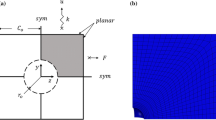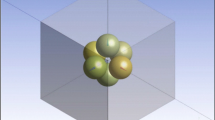Abstract
Effect of plastic compressibility on void growth ahead of a moving crack-tip is investigated numerically for a mode I crack subjected to plane strain deformation with small-scale yielding. Exploration is made for quasi-static finite deformations of isotropic hardening elastic–viscoplastic solids. For comparison purpose, both plastically incompressible and plastically compressible solids are considered to study the crack-tip deformation, void growth and interaction between the crack-tip and a nearby void by examining the near tip distributions of plastic strain, hydrostatic stress, effective stress and stress triaxiality. The plastic compressibility is found to have strong effect on the crack-tip deformation and stress–strain fields in the ligament and void region. The shape of void growth in front of the crack-tip is significantly influenced by the plastic compressibility. The present results show that in the case of plastically compressible solids, the rate of void growth in the direction perpendicular to the crack plane is more than the corresponding in the direction parallel to the crack and this observation is in sharp contrast to the void growth behavior observed in plastically incompressible solids. The predictions of the crack-tip and void interaction in the presence of plastic compressibility may be very helpful in understanding the crack growth and void coalescence in some relatively newer materials having very high energy absorption capacity, highly desired electrical and thermal as well as radiation-resistant properties, properties of bioimplants, etc.










Similar content being viewed by others
Abbreviations
- \(a_{1}\) and \(a_{2}\) :
-
Current vertical radius and horizontal diameter of the void, respectively
- \(b\) :
-
Current crack opening
- \(b_{0}\) :
-
Initial notch radius
- CTOD:
-
Crack-tip opening displacement
- HRR:
-
Hutchinson, Rice, Rosengren
- \(d_{0}\) :
-
Center of the void from the notch center
- d :
-
Rate of deformation tensor
- \({\mathbf{d}}^{{\text{e}}}\) :
-
Elastic part of rate of deformation tensor
- \({\mathbf{d}}^{{\text{p}}}\) :
-
Plastic part of rate of deformation tensor
- E :
-
Young’s modulus
- F :
-
Deformation gradient
- \(g\) :
-
Hardness function
- I :
-
Identity tensor
- J :
-
Jacobian
- \(J_{{{\text{app}}}}\) :
-
Applied J-integral
- \(K_{{\text{I}}}\) :
-
Mode I stress intensity factor
- \({\mathbf{L}}\) :
-
Elastic moduli tensor
- m :
-
Strain rate sensitivity exponent
- N :
-
Power law hardening exponent
- \({\mathbf{p}}\) :
-
Deviatoric part of Kirchhoff stress tensor
- \(R_{0}\) :
-
Outer radius of the semicircular geometry
- \(\dot{u}_{1}\) and \(\dot{u}_{2}\) :
-
Rate of displacement in x and y directions, respectively
- \(\alpha\) :
-
Plastic compressibility parameter
- \({\varvec{\sigma}}\) :
-
Cauchy stress tensor
- \({\varvec{\tau}}\) :
-
Kirchhoff stress
- v :
-
Poisson’s ratio
- \({\hat{\varvec{\uptau }}}\) :
-
Jaumann rate of Kirchhoff stress
- \(\varepsilon_{{\text{p}}}\) :
-
Plastic strain
- \(\dot{\varepsilon }_{{\text{p}}}\) :
-
Plastic strain rate
- \(\dot{\varepsilon }_{0}\) :
-
Reference strain rate
- \(\varepsilon_{0}\) :
-
Yield strain
- \(\sigma_{{\text{e}}}\) :
-
Effective stress
- \(\sigma_{{\text{h}}}\) :
-
Hydrostatic stress
References
Alam MI, Khan D, Mittal Y, Kumar S (2019) Effect of crack tip shape on near-tip deformation and fields in plastically compressible solids. J Braz Soc Mech Sci Eng 41:441
Aoki S, Kishimoto K, Takeya A, Sakata M (1984) Effects of microvoids on crack blunting and initiation in a ductile material. Int J Fract 24:267–278
Aravas N, McMeeking RM (1985) Finite element analysis of void growth near a blunting crack tip. J Mech Phys Solids 33(1):25–49
Basu S, Narasimhan R (1996) Finite element simulation of mode I dynamic, ductile fracture initiation. Int J Solids Struct 33(8):1191–1207
Chang WJ, Pan J (1997) Cavitation instabilities in plastics and rubber-modified plastics. Int J Fract 88:61–86
Chang WJ, Kim M, Pan J (1997) Quasi-statically growing crack-tip fields in elastic perfectly plastic pressure-sensitive materials under plane strain conditions. Int J Fract 84:203–228
Chew HB, Guo TF, Cheng L (2006) Effects of pressure-sensitivity and plastic dilatancy on void growth and interaction. Int J Solids Struct 43:6380–6397
Cui Y, Chen Z, Ju Y (2019) Fundamental insights into the mass transfer via full dislocation loops due to alternative surface cuts. Int J Solids Struct 161:42–54
Deshpande VA, Fleck NA (2000) Isotropic constitutive models for metallic foams. J Mech Phys Solids 48:1253–1283
Guo TF, Cheng L (2003) Vapor pressure and void size effects on failure of a constrained ductile film. J Mech Phys Solids 51:993–1014
Gurson AL (1975) Plastic flow and fracture behavior of ductile materials incorporating void nucleation, growth and interaction. Ph. D. thesis, Brown University
Gurson AL (1977) Continuum theory of ductile rupture by void nucleation and growth: part I. Yield criteria and flow rules for porous ductile media. J Eng Mater Technol 99:2–15
Hutchens SB, Needleman A, Greer JR (2011) Analysis of uniaxial compression of vertically aligned carbon nanotubes. J Mech Phys Solids 59:2227–2237
Indurkar PP, Joshi SP (2019) Void growth and coalescence in porous plastic solids with sigmoidal hardening. J Appl Mech ASME 86:091001–091012
Khan D, Singh S, Needleman A (2017) Finite deformation analysis of crack tip fields in plastically compressible hardening–softening–hardening solids. Acta Mech Sin 33(1):148–158
Lai J, Van der Giessen E (1997) A numerical study of crack-tip plasticity in glassy polymers. Mech Mater 25:183–197
Li FZ, Pan J (1990) Plane-strain crack-tip fields for pressure-sensitive dilatant materials. J Appl Mech 57:40–49
Lubarda VA, Schneider MS, Kalantar DH, Remington BA, Meyers MA (2004) Void growth by dislocation emission. Acta Mater 52:1397–1408
McClintock FA (1968) A criterion for ductile fracture by the growth of holes. J Appl Mech 35:363–371
McMeeking RM (1977) Finite deformation analysis of crack tip opening in elastic–plastic materials and implications for fracture. J Mech Phys Solids 25:357–381
Mittal Y, Singh S, Khan D (2020). A numerical study of the effects of overload on fatigue crack growth in plastically compressible hardening and hardening–softening–hardening solids. In: Mechanics based design of structures and machines (Published online on June 19, 2020)
Mohan N, Cheng J, Greer JR, Needleman A (2013) Uniaxial tension of a class of compressible solids with plastic non-normality. J Appl Mech 80:040912-1-8
Narasimhan R (2004) Analysis of indentation of pressure sensitive plastic solids using the expanding cavity model. Mech Mater 36:633–645
Needleman A, Tvergaard V (1987) An analysis of ductile fracture modes at a crack tip. J Mech Phys Solids 15:151–185
Needleman A, Hutchens SB, Mohan N, Greer JR (2012) Deformation of plastically compressible hardening–softening–hardening solids. Acta Mech Sin 28:1115–1124
Needleman A, Tvergaard V, Van der Giessen E (2015) Indentation of elastically soft and plastically compressible solids. Acta Mech Sin 31(4):473–480
Peirce D, Shih CF, Needleman A (1984) A tangent modulus method for rate dependent solids. Comput Struct 18:875–887
Rice JR (1968) A path independent integral and the approximate analysis of strain concentration by notches and cracks. J Appl Mech 90:379–386
Rice JR, Tracey DM (1969) On the ductile enlargement of voids in triaxial stress fields. J Mech Phys Solids 17(3):201–217
Rice JR, Johnson MA (1970) Inelastic behavior of solids. In: Kanninen MF, Adler WG, Rosenfield AR, Jaffee RI (eds). McGraw-Hill, New York, pp 641–672
Rudnicki JW, Rice JR (1975) Conditions for the localization of deformation in pressure-sensitive dilatant material. J Mech Phys Solids 23:371–394
Shih CF (1981) Relationship between the J-integral and the crack opening displacement for stationary and extending cracks. J Mech Phys Solids 29:305–326
Singh S, Khan D (2018) On fatigue crack growth in plastically compressible hardening and hardening–softening–hardening solids using crack tip blunting. Int J Fract 213:139–155
Spitzig WA, Richmond O (1979) Effect of hydrostatic pressure on the deformation behavior of polyethylene and polycarbonate in tension and compression. Polym Eng Sci 19(16):1129–1139
Subramanya HY, Viswanath S, Narasimhan R (2008) Influence of crack tip constraint on void growth in pressure sensitive plastic solids—I: 2D analysis. Eng Fract Mech 75:1045–1063
Sui H, Yu L, Liu W, Chen L, Duan H (2020) Three dimensional dislocation-loop emission criterion for void growth of ductile metals. Int J Plast 131:102746
Sun J, Deng ZJ, Tu MJ (1991) Effect of stress triaxiality levels in crack tip regions on the characteristics of void growth and fracture criteria. Eng Fract Mech 39(6):1051–1060
Tekoğlu C, Hutchinson JW, Pardoen T (2015) On localization and void coalescence as a precursor to ductile fracture. Philos Trans R Soc A 373:20140121
Tvergaard V, Needleman A (1984) Analysis of cup–cone fracture in a round tensile bar. Acta Metall 32:157–169
Yuan H, Lin G (1993) Elastoplastic crack analysis for pressure-sensitive dilatant materials. part I: higher-order solutions and two-parameter characterization. Int J Fract 61:295–330
Yuan H (1994/1995) Elastoplastic crack analysis for pressure-sensitive dilatant materials. Part II: interface cracks. Int J Fract 69: 167–187
Author information
Authors and Affiliations
Corresponding author
Additional information
Technical Editor: João Marciano Laredo dos Reis.
Publisher's Note
Springer Nature remains neutral with regard to jurisdictional claims in published maps and institutional affiliations.
Rights and permissions
About this article
Cite this article
Bandil, P., Khan, D., Shah, P. et al. Numerical simulation of void growth in front of a blunting crack-tip in plastically compressible solids. J Braz. Soc. Mech. Sci. Eng. 43, 152 (2021). https://doi.org/10.1007/s40430-021-02855-3
Received:
Accepted:
Published:
DOI: https://doi.org/10.1007/s40430-021-02855-3




